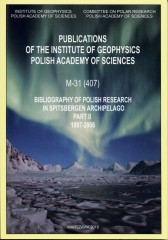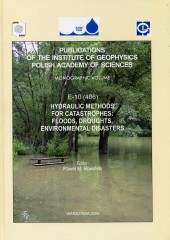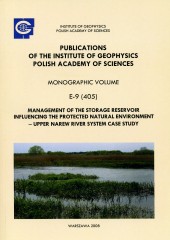BROWSE - VOLUME LIST
- A - Physics of the Earth's Interior
- B - Seismology
-
C - Geomagnetism
C-119, C-118, C-117, C-116, C-115, C-114, C-113, C-112, C-111, C-110, C-109, C-108, C-107, C-106, C-105, C-104, C-103, C-102, C-101, C-100, C-99, C-98, C-97, C-96, C-95, C-94, C-93, C-92, C-91, C-90, C-89, C-88, C-87, C-86, C-85, C-84, C-83, C-82, C-81, C-80, C-79, C-78, C-77, C-76, C-75, C-74, C-73, C-72, C-71, C-70, C-69, C-68, C-67, C-66, C-65, C-64, C-63, C-62, C-61, C-60, C-59, C-58, C-57, C-56, C-55, C-54, C-53, C-52, C-51, C-50, C-49, C-48, C-47, C-46, C-45, C-44, C-43, C-42, C-41, C-40, C-39, C-38, C-37, C-36, C-35, C-33, C-32, C-31, C-30, C-29, C-28, C-27, C-26, C-25, C-24, C-23, C-22, C-21, C-20, C-19, C-18, C-17, C-16, C-15, C-14, C-13, C-12, C-11, C-10, C-9, C-8, C-7, C-6, C-5, C-4, C-3, C-2, C-1
-
D - Physics of the Atmosphere
D-79, D-78, D-77, D-76, D-75, D-74, D-73, D-72, D-71, D-70, D-69, D-68, D-67, D-66, D-65, D-64, D-63, D-62, D-61, D-60, D-59, D-58, D-57, D-56, D-55, D-54, D-53, D-52, D-51, D-50, D-49, D-48, D-47, D-46, D-44, D-45, D-43, D-42, D-41, D-40, D-39, D-38, D-37, D-35, D-34, D-33, D-32, D-31, D-30, D-28, D-27, D-26, D-25, D-24, D-23, D-22, D-21, D-20, D-19, D-18, D-17, D-16, D-15, D-14, D-13, D-12, D-11, D-10, D-9, D-8, D-7, D-6, D-5, D-4, D-3, D-2, D-1
- E - Hydrology
- P - Polar Research
- M - Miscellanea
-
Online First
Browse - Volume list
Results of Geomagnetic Observations; Belsk, Hel, Hornsund, 2008
Author(s): Reda J., Neska M., Wójcik S.
Volume: 409
Series: C-102
Volume: 409
Series: C-102
This publication contains basic information on geomagnetic observations carried out in 2008 in three Polish geophysical observatories: Belsk (BEL), Hel (HLP), and Hornsund (HRN). All these observatories belong to the Institute of Geophysics, Polish Academy of Sciences. Observatories Belsk and Hel are located on the territory of Poland, while Hornsund is in Spitsbergen archipelago, governed by Norway.
Results of Geomagnetic Observations; Belsk, Hel, Hornsund, 2007
Author(s): Reda J., Neska M., Wójcik S.
Volume: 408
Series: C-101
Volume: 408
Series: C-101
This publication contains basic information on geomagnetic observations carried out in 2007 in three Polish geophysical observatories: Belsk (BEL), Hel (HLP), and Hornsund (HRN). All these observatories belong to the Institute of Geophysics, Polish Academy of Sciences. Observatories Belsk and Hel are located on the territory of Poland, while Hornsund is in Spitsbergen archipelago, governed by Norway.
Bibliography of Polish Research in Spitsbergen Archipelago. Part II: 1997-2006
Editor(s): Giżejewski J.
Volume: 407
Series: M-31
Volume: 407
Series: M-31
We are giving to the still growing community of people interested in Spitsbergen and its surroundings a second part of the Bibliography of Polish Research in Spitsbergen Archipelago, covering the years from 1997 to 2006. The aim of the editors was to gather bibliographic information on scientific papers of Polish researchers. In some cases, we took into account foreign authors who closely cooperated with Polish teams in the area of Spitsbergen and around: Greenland, Iceland, Greenland Sea, Barents Sea, and the Russian Arctic. We also included publications of popular-science and informative character, which contribute to the history of research in the period covered by the Bibliography.
Hydraulic Methods for Catastrophes: Foods, Droughts, Environmental Disasters
Editor(s): Rowiński P.
Volume: 406
Series: E-10
Volume: 406
Series: E-10
The overall theme of the 28th School of Hydraulics was Hydraulic Methodsfor Catastrophes: Floods, Droughts, Environmental Disasters. Most of the presentationswere therefore devoted to a variety of problems that may contribute to increaseour knowledge in the description or prediction of extreme situations that wedeal with in aquatic environment and where hydraulic methods offer important solutions.All the papers presented during the School (after thorough review procedure)are presented in this volume.
Management of the Storage Reservoir Influencing the Protected Natural Environment - Upper Narew River System Case Study
Editor(s): Napiórkowski J.
Volume: 405
Series: E-9
Volume: 405
Series: E-9
One of the aims of the recently introduced Framework Water Directive (Directive 2000/60/WE) is the protection of the natural environment from further degradation. In the case of catchment systems, in which water retention reservoirs play an important role, maintenance of the desirable status of the natural environment under protection requires not only securing higher flows during periods of vegetation growth, but also introducing or keeping the flood impulse.






